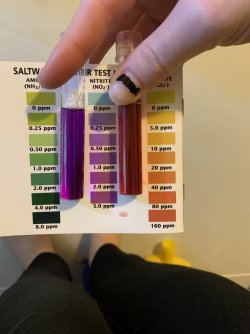Apwhite
New Member
Right now I’m cycling my first 10g saltwater tank. I’m about a week into the cycle right now. I’ve been testing the water every other day and today the readings seem a bit strange. Ammonia is zero and nitrite/trate seems pretty high. I wasn’t sure exactly how high so I attached an image. Obviously these levels are unsafe fire fish. What should I do about them? I read that adding too much ammonia can cause levels to spike a ton so could this be what happened? Should I stop adding ammonia for a little while (I added a mere three drops two days ago, 20 drops a few days before that, and 40 drops initially)? If I should stop adding ammonia, how long should I wait before adding it again and how much should I add after that? And will nitrates naturally lower or will I have to do a water change? And for that level of nitrates, will I have to do multiple water changes?




